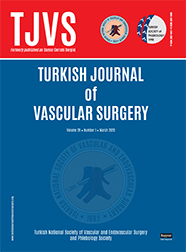
The Turkish Journal of Vascular Surgery
Yazarlar: Gökhan ARSLAN, Murat UĞUR, İbrahim ALP, Veysel TEMİZKAN, Ertürk YEDEKÇİ, İsmail SELÇUK, Alper UÇAK, Ahmet Turan YILMAZ
Konular:-
Anahtar Kelimeler:Carotid stenosis; filter; stent
Özet: Objective: Endovascular procedures can be performed for the treatment of carotid artery stenosis when there is a high risk for surgery or due to patient choice. We present carotid artery stent implantation experience of the cardiovascular surgery department in the hybrid operating room. Material and Methods: In our department, 20 carotid artery stenosis of 19 patients were treated with endovascular procedures between April 2009 and August 2012. The mean age was 68.7±8.2 years and 73.6% (n=14) of the patients were males. Nine patients had history of cerebrovascular events. The symptoms were dizziness in ten patients and amaurosis fugax in one patient. All patients were treated using self expandable stents under local anesthesia. Predilatation was performed in one patient and embolic protection devices were used in three patients. Following control angiography, postdilatation was performed in 35% (n=7) of patients due to residual stenosis ≥ 30%. Results: All stenoses were suc- cessfully treated with the endovascular approach. One patient underwent operation due to acute stent occlusion. Stent implantation to the right coronary artery was done in one patient due to myocardial infarction. There were one minor neurological event and one right hemiplegia. Conclusion: Endovascular treatment of carotid artery may be performed in elective cases in the hybrid operating room. Usage of embolic protection devices and predilataion may increase neurological complication rates due to increased manipulation. We suppose that plaque fixation with stent implantation as the first step, and instent postdilatation after control angiography will decrease the neurological event rates of endovascular treatment of carotid stenosis.